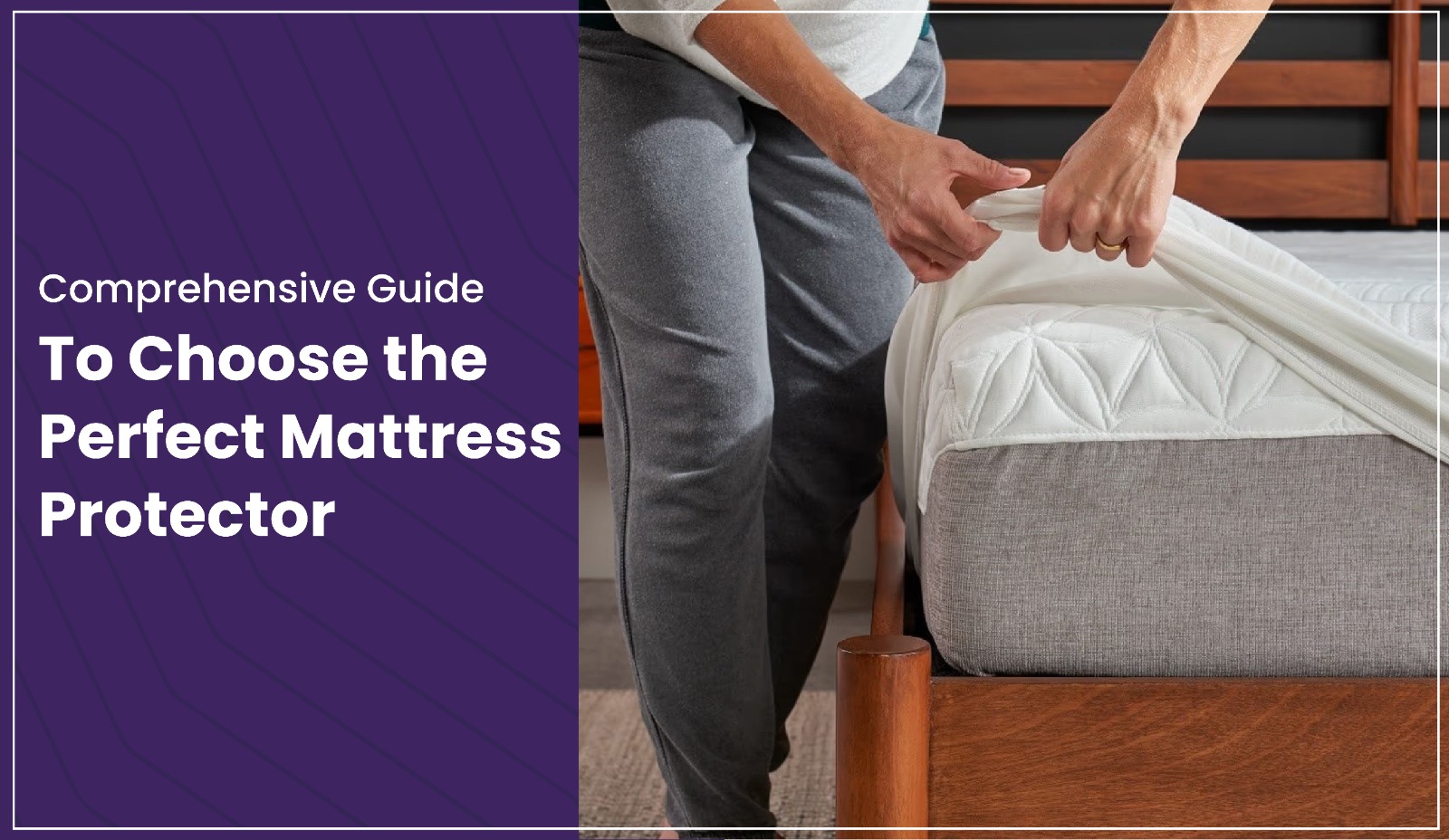Blog
Comprehensive Guide to Choose the Perfect Mattress Protector

Introduction
The proper mattress protector plays a pivotal part in prolonging the comfort and lifespan of your bedding. With many alternatives available, identifying one that meets your demands and affordability is key. This overview aims to guide you through various characteristics and elements to ensure you choose the most suitable choice to elevate your sleep.
What is a Mattress Covering?
A mattress covering, fundamentally, refers to a defensive item intended to shield the mattress from dirt and stains through regular laundering; such covers fulfil protective functions tailored for mattress protection.
While alternatives vary considerably in cost, fabric composition, and safeguarding abilities, selecting one with breathable, moisture-wicking cloth protects against allergens and permits air circulation for optimal sleeping. From rigid plastic shells to flexible, padded encasing, evaluating individual needs assists in choosing the most fitting protector.
Protectors serve a unique purpose distinct from sheets, pads, or toppers. They add comfort while protecting pillows, mattresses, and stuffed items from spills, stains, and allergens.
Why Do You Need a Mattress Protector?
Is a mattress protector really necessary? Here are some of the top reasons to invest in one:
- Accidents happen, and a protector prevents liquids from penetrating the mattress, keeping it clean and stain-free.
- Dust mites, pet dander, and allergens can accumulate in the mattress. A hypoallergenic protector can block these allergens, helping you breathe easier.
- A protector adds a layer of defence that keeps the mattress looking new and functional for longer.
Types of Mattress Protectors
There are several types of best mattress protectors available, each offering different benefits. Here’s a breakdown to help you decide:
Fitted Protectors
Fitted protectors resemble fitted sheets, featuring elastic edges to secure themselves snugly over the mattress and ensure it remains in place through the night. Not only can this fitted mattress cover protect it against spills, stains, dust mites, and additional layers of comfort, but its ease of removal and cleaning make them practical options suitable for daily use, with cotton, polyester, or waterproof options catering to different preferences.
Encasement Protectors
Encasement protectors offer comprehensive mattress coverage by sealing it with a secure zipper, providing all-around protection from dust mites, bed bugs, and allergens from entering.
They’re especially beneficial to individuals suffering from allergies or sensitivities because these durable protection systems block dust mites, bed bugs, and allergens from getting inside – something dust mite covers cannot do.
Encasement protectors are beneficial for maintaining a clean sleeping environment, especially for individuals with severe allergies or asthma. They create a barrier that helps keep allergens at bay and are easy to care for, as they can be washed with regular bedding. Investing in encasement protectors provides long-term protection and improves overall sleep quality.
Topper Style Protectors
Topper-style mattress protectors are specially made to add additional layers of cushion and comfort without the expense or maintenance burdens associated with standard fitted protectors.
Topper protectors often come in thicker than fitted protectors, creating an inviting sleeping surface while protecting from spills, stains, and wear and tear.
Topper-style protectors feature materials such as memory foam or gel-infused fabrics that regulate temperature while offering pressure relief – an excellent way to increase sleep quality without replacing an entire mattress altogether! Additionally, topper-style protectors can easily be removed for washing so your mattress stays protected over time, ensuring its continued health.
Waterproof vs Water-resistant Protectors
| Feature | Waterproof protectors | Water resistant protectors |
| Level of protection | Provides complete protection against spills, leaks, and moisture | Offers lighter protection, repelling minor spills and moisture |
| Material | Typically made from polyurethane or vinyl, creating a waterproof barrier | Often made from breathable fabrics that allow for airflow |
| Suitability for Families | Ideal for families with children or pets or anyone prone to accidents | Versatile option for households with lower spill risks |
| Breathability | Maybe less breathable, but many modern options allow for airflow | Generally more breathable, helping to regulate temperature |
| Impact on Mattress Health | Safeguards against stains, odours, allergens, and dust mites | Helps maintain cleanliness but may not fully prevent liquid penetration |
| Maintenance | Easy to clean and maintain; often machine washable | Also easy to clean; typically machine washable as well |
| Comfort | May feel less comfortable due to the waterproof layer | Prioritises comfort and sleep quality while offering some protection |
| Best For | Households with high spill risks or nighttime accidents | Individuals seeking a balance between comfort and protection |
Materials to Consider for Mattress Protector
Material choice plays a huge part in terms of comfort, breathability, and durability of mattress protectors. Common materials include:
Cotton
Soft, breathable, and ideal for those seeking a natural material.
Polyester
Often used in waterproof protectors, polyester is durable and affordable but less breathable.
Bamboo
Bamboo material, derived from bamboo plant, is both eco-friendly and hypoallergenic, making it the ideal material choice for allergy sufferers.
Tencel
Derived from sustainably sourced wood pulp & Known for its softness and breathability, Tencel is a top choice for those looking to stay cool and comfortable.
Size and Fit: Getting It Right
Before purchasing a mattress protector, ensure it fits your mattress size. Standard bed sizes for mattress covers are available—twin, queen, or king beds should all measure the same size, so it is wise to check the dimensions of the protectors before making your selection.
Measure Your Mattress Depth
Some protectors accommodate deeper mattresses, so know your mattress’s height.
Elasticity and Hold
Look for protectors with elastic sides if you’re concerned about a secure fit.
Breathability and Cooling Features
Nobody wants a sweaty night’s sleep. If you sleep hot, consider a mattress protector with cooling properties. Some materials, like bamboo or Tencel, are naturally cool, while others may have unique cooling technology to regulate body temperature throughout the night.
Hypoallergenic Options
If you suffer from allergies, a hypoallergenic mattress protector can make a big difference. These protectors are designed to block common allergens like dust mites and pollen, offering a cleaner and healthier sleep environment.
Ease in Maintenance
Consider these steps related to upkeep maintenance before buying or using a mattress protector:
- Mattress protectors can generally be washed – just read their labels carefully first!
- In an emergency, opt for the material that dries quickly or look for protectors resistant to stains for quicker cleanup.
How to Choose a Budget-Friendly Mattress Protector?
Although countless sleeping mattress protector options are available today at a wide range of price points, they can’t all be excellent, can they? Here’s how to make a wise choice without going over budget:
-
Set a Budget
Determine what you’re willing to spend and narrow your options accordingly.
-
Compare Features:
Look at durability, materials, and extra features like waterproofing or hypoallergenic qualities to see which protector offers the best value for your money. There is a brief table for you to get a better idea of it:
| Durability | Materials | Waterproofing | Hypoallergenic Qualities | Additional Features |
| Seek for reviews and descriptions about the product itself that speak about durability.
A more durable product would certainly cost a few dollars more, perhaps with a higher one-time upfront cost, but would save more money in the long term by not ever having to replace the product. |
Focus on the protector’s material. Materials like cotton are more breathable than synthetic ones. | If you need protection against spills or splashes, the protector needs to be waterproof, protecting your mattress and making it last longer. This can prevent damage to your mattress and extend its life. | A hypoallergenic protector can greatly minimise allergens, like dust mites, mould, and pet dander, in a house with allergies. | Some protectors feature special extras, such as cooling technology or extra padding for comfort. You should consider these add-ons and then compare them against your budget and needs. |
FAQs
-
- Why is there a need to use a mattress protector?
Protect your mattress to prevent the contact of spills, stains, and allergens for an extended period. - How often will the mattress and protector be recommended to be washed?
It must be washed once a month or after two months. However, you can also wash it as needed. - Do Mattress Protectors reduce comfort?
Well, no more than they can any other time — unless you go for a quality protector made of soft, breathable material. - What is the lifespan of a mattress protector?
A mattress protector will last 3 to 5 years and be regularly used, depending on the material type.
- Why is there a need to use a mattress protector?
